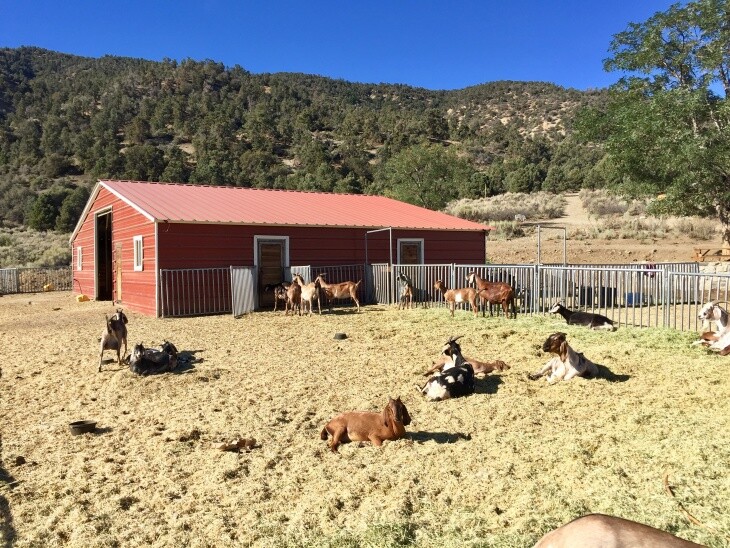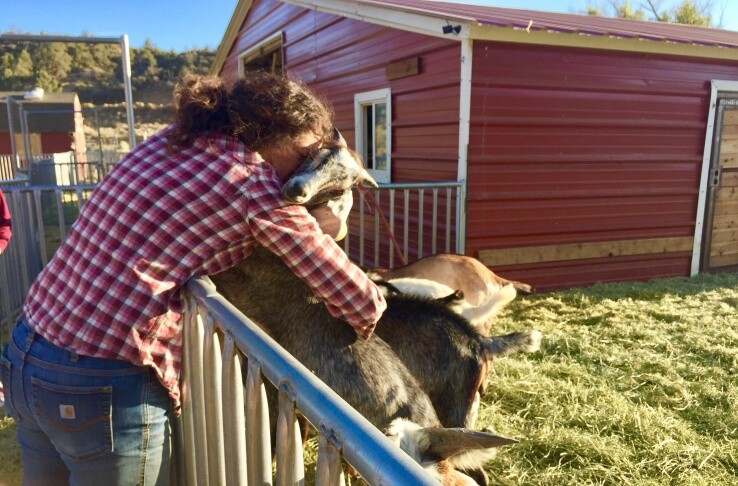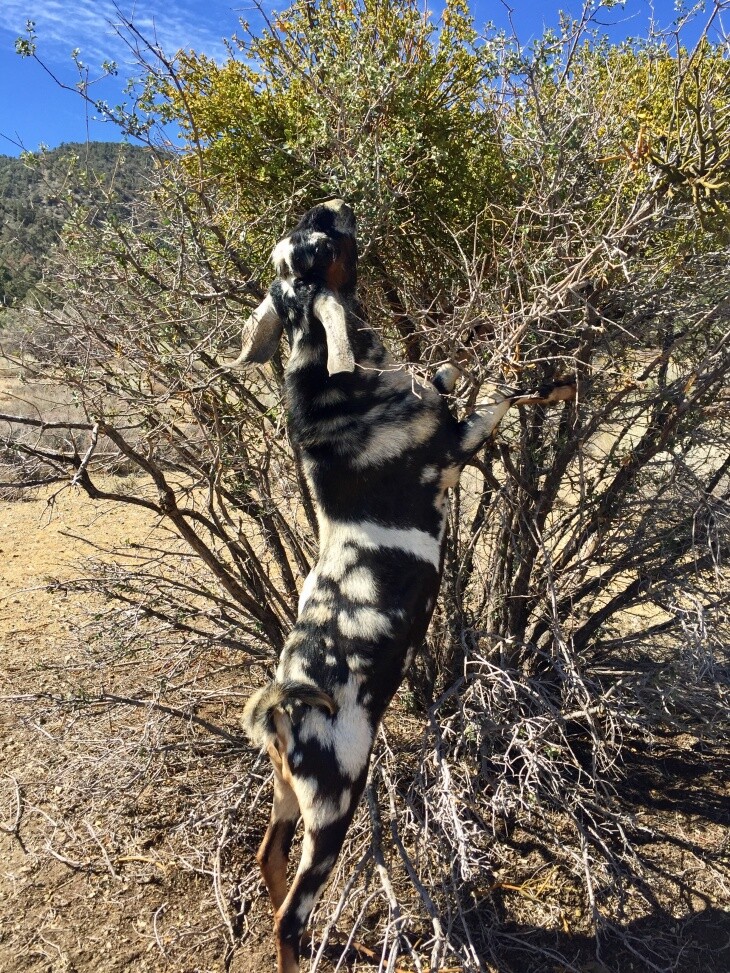Truth matters. Community matters. Your support makes both possible. LAist is one of the few places where news remains independent and free from political and corporate influence. Stand up for truth and for LAist. Make your year-end tax-deductible gift now.
A Day In The Life Of LA's Hippest Dairy Goats

Long before goats became GOAT (the Greatest Of All Time) with viral videos, goat yoga and a Taylor Swift remix, Gloria Putnam was getting up every day at dawn to tend to her animals. She bought her first two goats a decade ago, while living in Altadena, so she could have fresh milk. She dubbed the project Mariposa Creamery and kept the goats on about 1.25 acres at the historic Zane Grey estate, designed by Rose Bowl architect Myron Hunt.
By 2015, Putnam was ready to expand. She bought land near the tiny Mojave Desert town of Valyermo (pop. 450) and opened Angeles Crest Creamery. She and her partner, Christian Sariol, oversee the micro-dairy's operations.
Putnam's creameries have never been about commercial production. She calls Angeles Crest Creamery an "agricultural research project" says its main purpose is land restoration. She also wants to develop "a herd that thrives on the forage without a lot of unsustainable inputs."

Her main source of income in Altadena was cheese-making classes. Today, Angeles Crest Creamery is funded by agritourism with educational events like goat hikes and AirBnb farmstays where guests sleep in an Airstream trailer or a tiny lakeside cabin.
Accessed by winding roads through the San Gabriel Mountains, the micro-dairy is on a remote 70-acre plot. Pinyon Ridge, along the boundary of Borrego Valley, lies to the south and Big Pines Highway runs along the north side. Putnam's land lies in a canyon that runs along the San Andreas fault. It has a riparian zone, the area where a body of water meets land, centered around a sag pond. It also has "acres of sagebrush-dominated chaparral and a pinyon juniper woodland that rises to Pinyon Ridge, rising about 800 feet above the canyon floor," she says. Perfect for a flock of 20 goats.

"Goats are very social and need a large group," Putnam says. "They were domesticated after dogs so goats are very communicative and have more personality."
Putnam now has a herd of 60 Nubian goats aged 3 months to 11 years, but you'll have to do your downdog elsewhere. Angeles Crest isn't some thirsty, faux-rustic operation jumping on the goat yoga bandwagon because it's desperate for Instagram approval.
"I love goats and I love yoga," says Putnam, "but no one really wants a 150-pound Nubian trying to jump on them during child's pose. Also, our goats are too busy. They don't have time for yoga."

Angeles Crest Creamery is a working ranch. It isn't open to the public except for events and visits by farmstay guests.
Putnam raises her goats, along with a few turkeys and chickens, for milk, eggs and meat. She also has a few horses, a donkey and a large kunekune pig named Katie. Four Great Pyrenees dogs guard the animals and a couple of house dogs roam the grounds. Putnam feeds herself and her family with the animals she raises. She also sells them to guests and sometimes to restaurant chefs.
What exactly do these goats do all day that keeps them from practicing warrior pose? We got the answer straight from the horse's -- er, goat's -- mouth.

Sunrise, 6 a.m. -- Hay, Boys
Us young male goats all hang out together in the same pen around the barn. Gloria says we can't forage in the wild after we're 3 months old and become fertile *sigh*. (She only uses one buck for breeding.) So she feeds us locally grown Lancaster hay made from a mix of grass and alfalfa. I guess it's not a bad deal. It's kind of like ordering room service for your bachelor pad.

6-9 a.m. -- Got Milk?
Some of us lady goats have extra milk to give. Those of us who have been pregnant or are old enough, about 10 of us right now, can go in the milking barn. Some of us are more eager than others and bang on the outside of the barn door. When Gloria opens the door, we usually run in, four at a time. We're supposed to step onto a small platform, put our head through a holder and eat food from a bowl while she milks us. But some of us know how to work the system. We stay on the ground and head straight for the food. Gloria guides us to the platform and we do things her way. Busted.

Most of us gobble up the food right away. Turns out, it's tasty. It's good for us. The organic feed made especially for growing and lactating goats is made from corn, wheat, peas, soybean meal, barley and alfalfa and it has tons of beneficial nutrients and carbs. Paleo? As if. Bring on the grains!

Gloria is a pro at milking. She milks each of us quickly by hand into a pot and then dumps the milk into a large filtered container. Sometimes, the farmstay guests milk us too. Their milking skills can be... interesting. It can take them a while to get the hang of it and we'll stomp or kick to let them know we've had enough.

We also get some looky-loos. Other goats watch us from across the fence while they wait their turn. I guess this is what Kim Kardashian feels like when she tries to eat a taco.

Some of us aren't milked to make sure we have enough to feed our babies. Dot is pregnant with two right now so she's not milking, just feeding. We're not bred for mainly milk production but Gloria makes things with our milk like cheese, cajeta (goat's milk caramel) and yogurt that her family or the farmstay guests can eat. You could say Gloria really milks our supply as much as she can. Sorry, inside joke.
Morning Until Dusk: Forage
If we had a playlist, this is when we'd listen to George Michael's "Freedom!" After milking is done, all of us except for the young boys and perhaps a couple older goats are let out of the barn and pens so we can roam and eat freely off the land the rest of the day. Gloria calls this foraging. We call it life.
We eat different trees and shrubs including buckwheat, poppies, scrub oak and mistletoe, depending on the season. Autumn arrives early in our neck of the woods, kind of like Starbucks releasing the pumpkin spice latte in August. Right now, summer plants like desert almond are drying up and fall plants such as sagebrush and chaparral are blooming.

In the winter, when the chaparral dries out, we eat more pine. Grass doesn't provide enough minerals, so it's good for us to eat things with deeper roots. Our foraged food also gives us protein.
Some of us like to show off. We call this the goat version of tree pose.

We usually travel in a large group to ward off coyotes and other predators.
It's also good for "maximum soil disturbance," Gloria says. When we're roaming and eating, we're also helping her by fertilizing and working the land with our hooves. This is part of regenerative agriculture, which goes a step beyond sustainability. We're not just maintaining the land, we're improving it. We're thinking about forming a union and charging for our services.

Gloria sometimes hangs out with us to make sure we switch up our routes. Sometimes our herd queen, 6-year-old Apple, leads us. She keeps a watchful eye over all of us and when she eats, no one else eats next to her except her daughter.
Apple's mother was the herd queen before her, which is common, but Apple still had to earn her position. She and Dot fought for the title by clashing horns for three weeks. Apple prevailed. Then last year, when Apple was injured, Dot tried to dethrone her but Apple got well and put Dot back in her place. It's no Game of Thrones but we have our share of royal drama.
Here's our queen, Apple, getting milked:

The guard dogs -- Paisley Jane, Gilbert Bleu, Don Luigi and Zita Marie -- stay behind while we forage. They have the whole napping thing down. They need their rest since they stay up at night, protecting us from coyotes. We really are celebrities, we get our very own guards.

Throughout The Day: Hydrate And Relax
Foraging is hard work. If we had Fitbits, we'd smash that 10,000 steps a day goal. So we like to take breaks. Lots of breaks.

We walk back to the barn to drink from a large water trough and rest in the shade. We can siesta with the best of them.

Then, it's back to eating. It's a hard knock life, I know.
Dusk: Supplements, Bro
At dusk we come to the barn for dinner. A mix of alfalfa and grass provides nutrients we don't get from foraging. You could call us pigs since we spend so much time eating -- up to 20 hours a day -- but we work it all off, I swear. Not that there's anything wrong with pigs. We love our friend Katie, the 3-year-old kunekune pig that Gloria keeps as a pet.

Dusk Til Dawn: Counting Stars
Now it's time for us to gather in the barn. We shuffle into the large common area and rest or sleep until the early morning, depending on how we feel. We don't have a strict bedtime, which is pretty sweet.

Tomorrow we'll do it all again. Another day of maximum chill in the life of a dairy goat.
You made it! Congrats, you read the entire story, you gorgeous human. This story was made possible by generous people like you. Independent, local journalism costs $$$$$. And now that LAist is part of KPCC, we rely on that support. So if you aren't already, be one of us! Help us help you live your best life in Southern California. Donate now.







